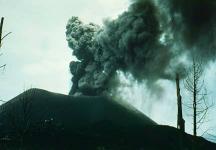2.3.3: Sources of Energy
- Page ID
- 15552
Forces that drive the Earth system derive their energy from a number of different sources. Exogenic processes are those driven by exogenic forces that primarily derive their energy from solar radiation. For instance, soil erosion is caused by the force of wind acting on bare ground. We can trace the energy that causes wind erosion to the receipt of solar radiation. How? Though we are jumping ahead ourselves, wind is a product of horizontal differences in pressure over distance caused by the unequal heating of the Earth's surface. Low pressure is created when heated air rises from the surface and then flows outward at a higher elevation. As air moves upward, the surface pressure decreases relative to the air around it. The variation in surface pressure causes air to move into the region of low pressure to replace that which is rising, thus creating a wind. Soil is detached when wind blows over an erodible surface. Water and glacial erosion are other examples of exogenic processes.

Endogenic processes are those that get their energy from endogenic forces originating deep within the Earth. Many of the great mountain systems like the Himalayas are a product of the collision of lithospheric plates. The movement of lithospheric plates is thought to result from convection currents in the mantle. Deep within Earth's mantle and lower crust, heat is generated by the radioactive decay of elements like uranium, thorium, and potassium. The heat is transferred upward to warm the mantle causing it to slowly circulate and tug on the plates above. The movement of plates fractures and folds rock, and their collision creates vast mountain chains and volcanic cones. (For more see: Some Unanswered Questions, The Dynamic Earth, USGS). So in the final analysis, endogenic forces tend to build things up while exogenic forces wear things down.




